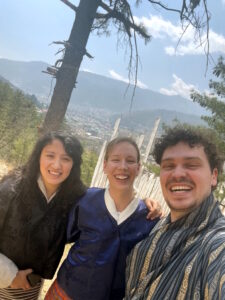We are two students from Lund University and spent two months travelling through Bhutan for data collection.
Since we were working on our master thesis in Bhutan, we couldn’t only do sightseeing but in our case that was the best that could have happened to us. In our research we investigated the use and potential of insulation materials on Bhutanese buildings.
Despite Bhutan’s extreme climate zones from tropical to alpine, buildings are mainly built without an insulation layer which is a standard component in Northern European buildings. This leads to extreme hot and extreme cold indoor temperatures and a high energy use to make indoor temperatures more comfortable.
Besides a simulation, we conducted an interview study to research people’s perception about the building situation.
Supported by JNEC, the engineering college in Dewathang, and our friends Samten and Divya, we got the opportunity to speak with 50 Bhutanese individuals in Thimphu, Bumthang and Samdrup Jonkhar. In these interviews we gathered valuable information for our study such as the incredible cultural importance of buildings which is weil maintained by strict building laws.
And how a local production of building materials is crucial to make them implementable in buildings because of the bad infrastructure which makes transportation very costly in Bhutan. That Bhutanese people are very critical towards modern building materials and that durability, cost-effectiveness, and performance of materials need to be proven to them.
But besides these information, the most amazing part about the interviews was to get so close to Bhutanese culture and people as we could have never been on a touristic trip. We were invited to so many coffees and meals that it was impossible to accept all offers. None of the people that we approached and asked for an interview ever denied our request to answer our questions. Those are only a few examples of the inspiring hospitality that we experienced in Bhutan.
When we arrived on the JNEC campus in Dewathang it was a very warm and welcoming experience. We got in touch with the students and stall, they tried to teach us their traditional archery and we had a lot of fun in the karaoke bar and at the clean-up event where we collected trash from the campus and surrounding streets. Meanwhile we were working on our report and the simulations in which we simulated the actual effects of an insulation layer on energy use and indoor temperatures in Bhutanese buildings.
The results are very much influenced by the climate zone. In the colder climates of Bhutan an insulation layer brings a clear improvement as indoor temperatures are overall raised and energy use is reducing. In hot climate zones it is useful to implement insulation to reduce the required size and energy use of the cooler. Without a cooler or with a small size cooler, insulation will help reduce extreme temperature peaks but will generally cause warmer indoor temperatures and therefore higher energy use than without insulation.
We spent the last weeks of our Bhutan trip back in Thimphu. While we were finishing our report, we had the chance to spend some more time on sightseeing. Visiting an art school, several temples and the spectacular Tiger’s Nest we encountered one more time the Bhutanese kindness and care. Usually, tourists need to have a guide in Bhutan to move around, but since we were students, we haven’t had one. Nevertheless, we got approached by guides at almost all sights and always got nice explanations and information. At Cheri Lhakhang we even got shown around by a monk who also invited us for lunch afterwards.
When we had to start our way home after two months in Bhutan we were filled with good memories, new friends and amazing experiences.
Text and photos Charlotte Behmer and Denis Roncevic,
Lund University


